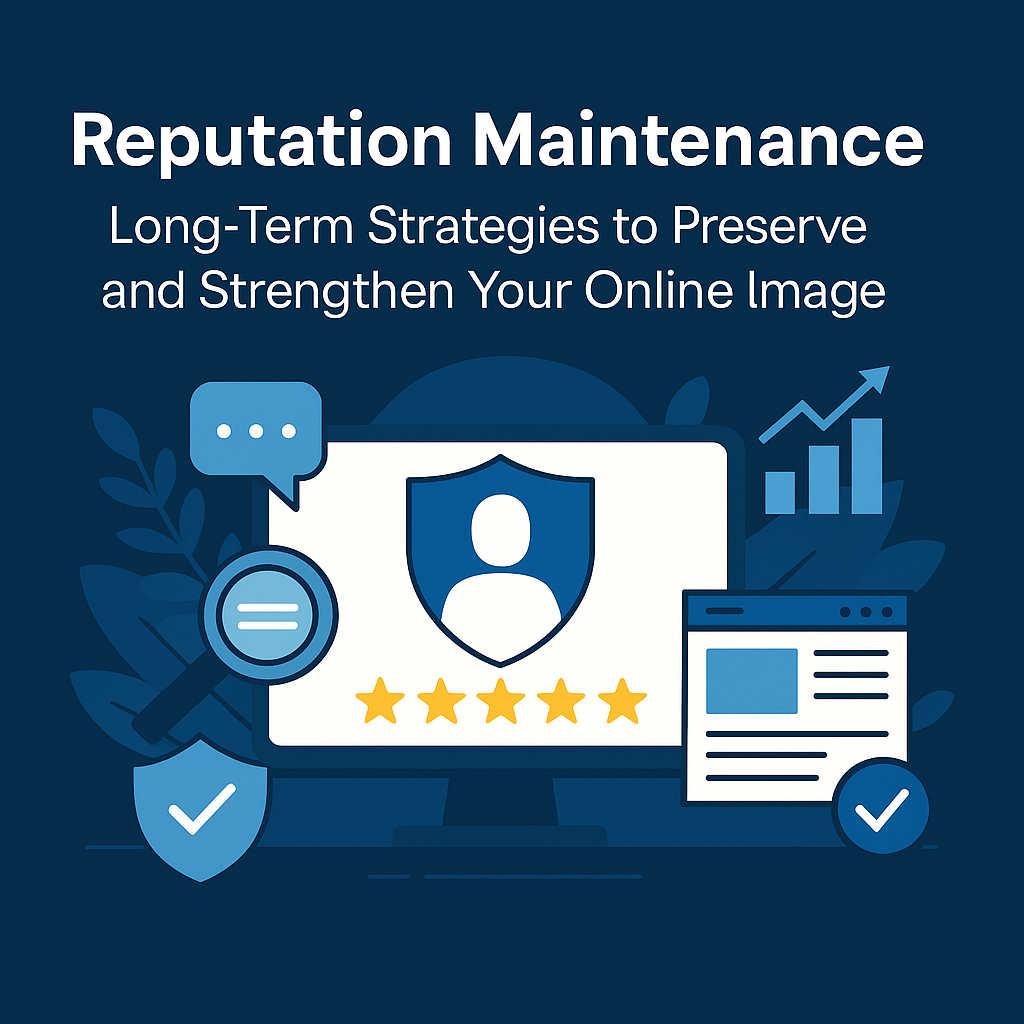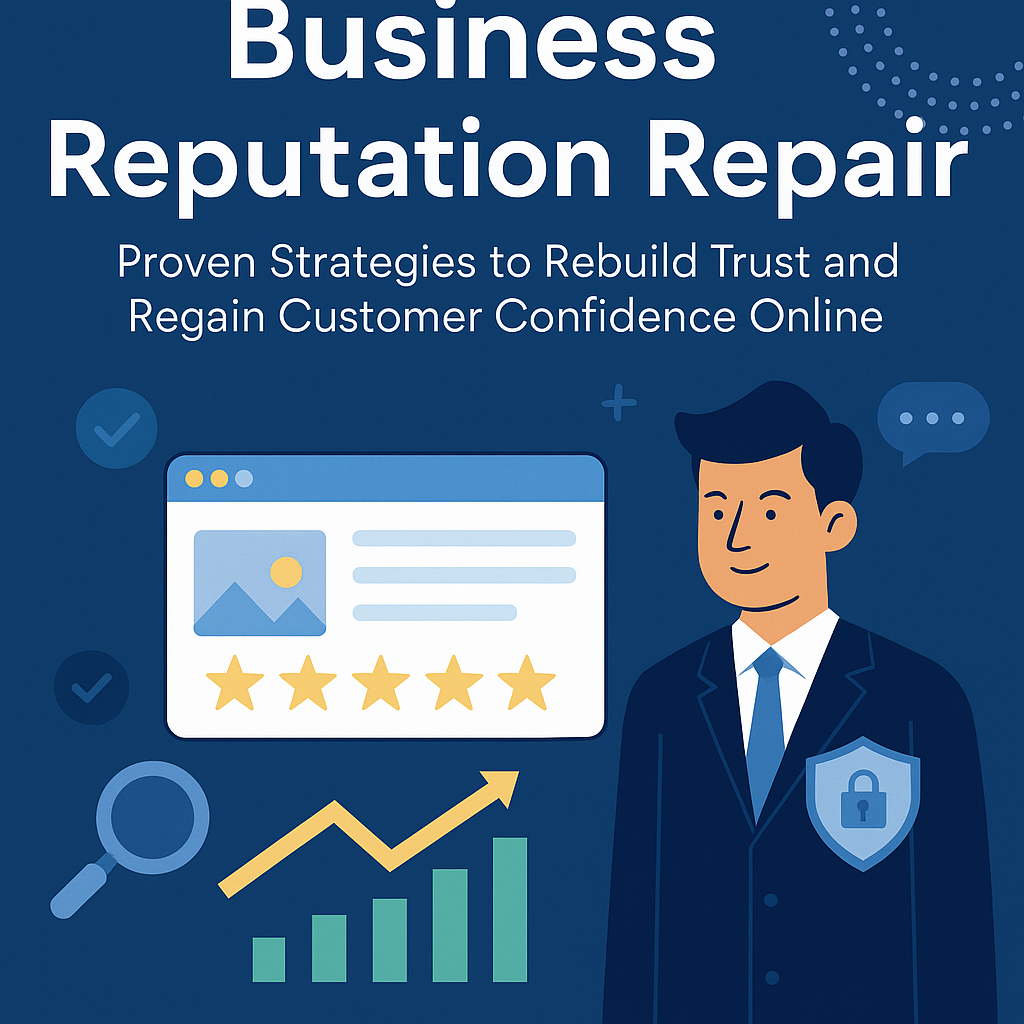Why Reputation Maintenance Is Critical in 2025 and Beyond
We live in an age where reputation is everything. A few bad reviews or a viral comment can impact your career, business, or personal brand. Proactive reputation maintenance is the modern shield that ensures your online persona remains strong, consistent, and trustworthy.
In contrast to short-term fixes, maintenance ensures that your reputation not only survives—but thrives—in search results, AI summaries, and social platforms.
Key Benefits of Ongoing Reputation Maintenance
- Keeps harmful content suppressed in search engines
- Strengthens credibility with customers and employers
- Prevents future attacks and misinformation
- Ensures consistent branding across platforms
- Optimizes visibility in Google, ChatGPT, and voice assistants
Core Pillars of Reputation Maintenance
1. Continuous Content Publishing
To stay ahead of negative or outdated mentions, you need a pipeline of high-quality content that keeps your brand fresh and favorable.
Actionable Tactics:
- Weekly blog posts tied to branded and reputation keywords
- Monthly press releases tied to milestones or charity work
- Guest posts and interviews on relevant industry sites
- Regular podcast or YouTube appearances
- Sharing achievements and awards on LinkedIn
Use tools like SurferSEO to align each post with on-page SEO best practices.
Also consider posting in multiple formats (written, video, infographic, slide decks). Content repurposing extends reach without duplicating efforts. Each content type attracts a different kind of audience and strengthens your omnipresence.
2. High-Authority Link Building
Backlinks remain one of the strongest signals in Google’s algorithm. Your site and content must be consistently linked from other reputable domains to maintain authority.
Link-Building Techniques:
- Resource page outreach
- Press placements via HARO (Help a Reporter Out)
- Brand mentions in industry directories
- Internal linking structures on your blog
- Sponsoring non-profit initiatives that offer backlink opportunities
Advanced tactics also include:
- Unlinked brand mention outreach
- Broken link building
- Building linkable assets (original studies, data reports, tools)
Link velocity—the rate at which backlinks are acquired—should remain consistent to avoid triggering spam filters.
3. Review Monitoring and Engagement
Online reviews shape public perception and rank in local SEO. It’s not enough to gather reviews once—ongoing management is key.
Best Practices:
- Respond quickly and professionally to all reviews
- Report fake or defamatory reviews
- Incentivize positive reviews ethically
- Use platforms like Trustpilot and Google Business to manage feedback
- Segment reviews by location, product, or service to identify patterns
- Develop internal protocols for review escalation
Encourage satisfied customers to leave photo reviews. Visual content tends to be favored by algorithms and appears more authentic.
4. Personal Branding Optimization
Whether you’re a CEO or content creator, your personal brand matters. Long-term maintenance involves keeping your online persona aligned with your goals.
Elements to Maintain:
- Updated bios across platforms (LinkedIn, personal site, Crunchbase, etc.)
- Professional headshots and imagery
- Verified social media accounts
- Structured data/schema markup for search engines
- A branded knowledge panel on Google
- Consistent tone, messaging, and aesthetic
Use Google’s Structured Data Testing Tool to validate schema markup.
5. AI Reputation Monitoring
With the rise of tools like ChatGPT, Perplexity, and Claude, reputation maintenance must include how you’re represented by AI.
AI Optimization Includes:
- Creating branded FAQs on your site
- Ensuring Wikipedia/Wikidata profiles are up to date
- Submitting corrections to AI platforms
- Including citations in all public-facing content
- Participating in Q&A forums like Quora and Reddit to guide public sentiment
- Publishing “About” pages with verifiable credentials and third-party validation
Track how your name appears in LLM summaries using tools like Perplexity’s profile monitor.
6. Legal and Compliance Monitoring
Sometimes, maintaining a clean online presence involves enforcing your rights.
Watch for:
- Defamation or false claims
- Copyright violations (trigger DMCA)
- Data breaches or leaks
- Content that violates privacy laws (CCPA, GDPR, etc.)
Maintain a legal playbook for fast takedown response. When possible, preemptively register your content to support enforcement actions.
7. Competitive Monitoring and Brand Intelligence
Staying ahead also means watching competitors and industry trends.
Tools and Tips:
- Use Brand24 or Mention for brand comparisons
- Analyze competitor backlinks and reputation tactics
- Subscribe to Google Trends and industry alerts
- Perform quarterly SWOT analysis
Understanding what others in your niche are doing helps inform your reputation maintenance roadmap.
Monitoring Tools to Automate the Process
| Tool | Use Case |
|---|---|
| Google Alerts | Track new mentions of your name or business |
| Mention | Real-time alerts across web and social |
| SEMrush/Ahrefs | Track backlinks, SEO health, keyword rankings |
| Trustpilot/Yext | Review aggregation and management |
| HighLevel CRM | Centralized customer messaging and review funnels |
| Brand24 | Social listening and sentiment analysis |
| BuzzSumo | Content performance and influencer tracking |
Case Study: From Reactive to Proactive with Optimize Up
A popular podcast host suffered from a surge of negativity due to a misquoted clip. They contacted Optimize Up to proactively reinforce their online image.
What We Did:
- Launched an ongoing blog and video campaign
- Built a branded personal website with schema and citations
- Engaged influencers and earned media mentions
- Used AI feedback forms to update ChatGPT and Perplexity content
Result:
- 6 new high-authority profiles appeared in top 10 results
- AI platforms updated their summaries
- YouTube video with positive messaging outranked the clip
Choosing the Right Partner for Reputation Maintenance
Not all firms offer real-time, long-term monitoring and action. Choose a solution that provides:
- Transparent performance dashboards
- Content development and SEO optimization
- Cross-platform support (Google, Bing, ChatGPT, X, Threads, LinkedIn)
- Review and legal support
Optimize Up offers scalable, white-label-ready ORM services backed by proven results.
👉 Contact Optimize Up to learn how we can preserve and grow your reputation.
Frequently Asked Questions
Reputation repair is reactive. Maintenance is proactive and long-term. It prevents issues before they arise.
Yes, but it’s time-consuming. Hiring a firm like Optimize Up ensures it’s handled strategically and consistently.
Ongoing. As long as you want to control how people perceive you online.
Plans range from $500 to $15,000+ per month based on your exposure and needs.
Absolutely. Structured, well-linked, and consistent content influences AI-generated content directly.
Look at improvements in branded search results, review scores, backlink growth, social sentiment, and AI summaries. Tools like Google Search Console, Brand24, and Perplexity help quantify changes over time.
You become vulnerable to negative content rising in rankings, outdated information resurfacing, and AI platforms referencing unverified data about you. Inaction can reverse years of progress.





